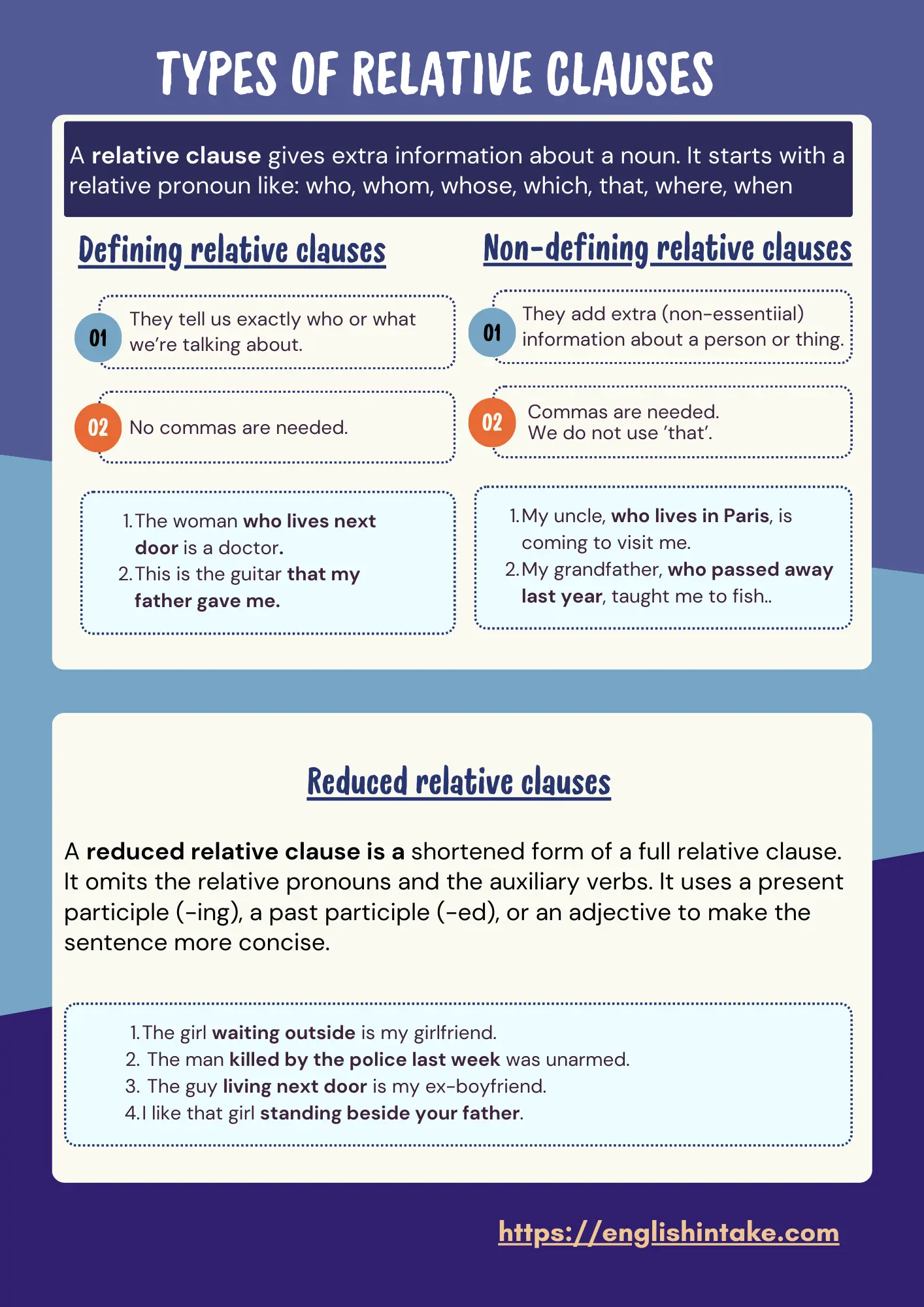1. What is a relative clause?
A relative clause is a type of dependent clause that provides more information about a noun using relative pronouns (who, whom, whose, which, that) or relative adverbs (where, when, why). They always follow the noun they describe, and each contains a subject and a verb. Relative clauses can't stand alone as sentences.
● Students who read books tend to perform well in their exams. (The relative clause 'who read books' specifies which students the sentence refers to. Without the clause, the sentence would imply that all students perform well, which is less precise.)
● I enjoyed the film that we watched last night.
● That is the restaurant where I first met my partner.
2. How to choose the correct relative pronoun?
To choose the correct relative pronoun, consider the following:
Use who or that for people
● I need the names of all the people who witnessed the incident.
● Those who previously took this medication reported side effects.
Use which or that for things
● The car which I bought last year is already having problems.
● The song that you recommended is now my favourite.
Use whose to show possession for people (and sometimes for things) in the same way you would use 'his'
● For example, 'I spoke to a friend, his uncle is a lawyer' is the same as 'I spoke to a friend whose uncle is a lawyer'.
● An effective leader is one whose actions are aligned with their stated values and principles.
For animals, you can usually use which or that, but who is also often used for pets.
● My neighbour has a dog who constantly barks.
● Animals that have hair or fur are called mammals.
● Giant pandas, which are vulnerable species, feed almost exclusively on bamboo.
3. Types

3.1 Defining and non-defining
Relative clauses can be defining (restrictive) or non-defining (non-restrictive). A defining relative clause gives essential information that tells you exactly which person or thing we are talking about. A non-defining relative clause adds extra, non-essential information about a person or thing.
We separate non-defining relative clauses from the rest of the sentence with commas. It is very important to remember not to use “that” in a non-defining relative clause.
Consider these examples:
● Defining: The athlete that won the race broke a record.
● Non-defining: London, where I was born, is a vibrant city.
In the first sentence, the relative clause is essential because it tells you which athlete is being discussed. In the second sentence, the relative clause 'where I was born' simply provides extra information, and you already know which city is being referred to.
You can use 'which' in a non-defining relative clause to refer to the entire sentence or situation. For example:
● My boss decided to end the workday early because of the blizzard, which I thought was a good idea.
Here, 'which' refers to the whole idea of the boss letting people leave early.
3.2 Rules for omitting relative pronouns
You can omit the relative pronoun (who, whom, which, that) if:
● It is the object of the verb in the relative clause.
● The clause is defining.
● There is no preposition directly before the pronoun (e.g., for which, to whom).
● The cake that you brought to my party was delicious.
○ In the relative clause 'that you brought to my party', the verb is 'brought', the subject is 'you', and the object is that', which refers to 'the cake'.
○ If you rewrite the sentence as “You brought the cake to my party,” you can see that “you” is the subject, and “the cake” is the object.
Since 'that' is the object of the verb in the relative clause, you can rewrite the sentence as:
○ The cake you brought to my party was delicious.
You cannot remove the relative pronoun if:
● The pronoun is the subject.
✓ The woman who teaches maths is my aunt.
✗ Incorrect: The woman teaches maths is my aunt.
● The clause is non-defining.
✓ The Eiffel Tower, which was completed in 1889, is a symbol of Paris.
✗ Incorrect: The Eiffel Tower, was completed in 1889, is a symbol of Paris.
● There is a preposition directly before the pronoun (e.g., in which, to whom).
✓ The house in which I grew up was built by my great-grandfather.
✗ Incorrect: The house I grew up was built by my great-grandfather.
● The pronoun is 'whose' (possession) or 'where/when' (place/time).
✓ The man whose leg was bitten by a shark died from his injuries.
✗ Incorrect: The man leg was bitten by a shark died from his injuries.
4. Reduced relative clauses
4.1 Definition
A reduced relative clause is a shortened form of a full relative clause. It omits the relative pronoun (e.g., who, which, that) and the auxiliary verbs (e.g., is, was) in the clause by using a present participle (-ing), a past participle (-ed), or an adjective to make the sentence more concise.
| Full forms of relative clauses | Reduced forms of relative clauses |
|---|---|
| I enjoyed the film that you recommended. | I enjoyed the film you recommended. |
| I like the guitar that hang next to the violin. | The like the guitar hanging next to the violin. |
| The scholar who had been nominated for the award published another article. | The scholar nominated for the award published another article. |
| The report that was submitted by our team was well-received. | The report submitted by our team was well-received by the CEO. |
| The man who is wearing a blue shirt is my father. | The man wearing a blue shirt is my father. |
| The building that is across from Robinson Hall is the Fenwick Library. | The building across from Robinson Hall is the Fenwick Library. |
4.2 Rules
If a relative pronoun is followed by the auxiliary verb 'be', you can remove both the pronoun and the 'be' verb.
● The magazines that are on the table belong to me. ⇛ The magazines on the table belong to me.
● People who were living by the River Severn had to evacuate due to the heavy floods. ⇛ People living by the River Severn had to evacuate due to the heavy floods.
If a relative pronoun is followed by a verb, you can change both into a verb ending in '-ing'.
● Apps that require frequent updates can be annoying. ⇛ Apps requiring frequent updates can be annoying.
● Laws that restrict freedom of speech must be amended. ⇛ Laws restricting freedom of speech must be amended.
If a relative pronoun is followed by the past perfect form (had been + past participle), you can remove the relative pronoun and 'had been', leaving the past participle.
● The song which had been written for the film won an award. ⇛ The song written for the film won an award
● The documents which were prepared for the meeting were accidentally deleted. ⇛ The documents prepared for the meeting were accidentally deleted.
In passive voice constructions (is/are/was/were + past participle), you can remove the relative pronoun and the 'be' verb, leaving the past participle.
●The regulations that were approved by the committee will take effect next month. ⇛ The regulations approved by the committee will take effect next month.
● The report that was submitted yesterday had some errors. ⇛ The report submitted yesterday had some errors.
Reduced relative clauses are common in:
● Travel guides: 'Souvenirs made locally'
● News headlines: 'PM facing criticism'
● Academic writing: 'Data collected from 200 participants ...'
